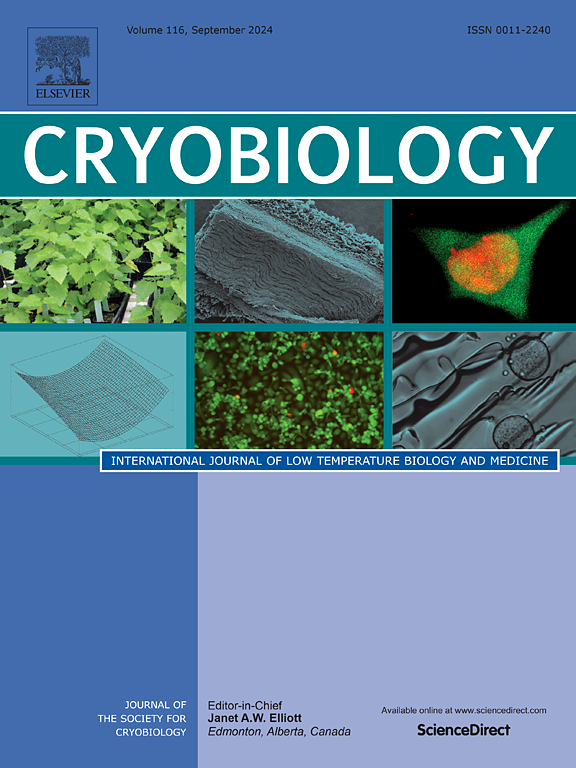亚环境温度下混合物中冷冻保护剂毒性和毒性降低的筛选
IF 2.1
3区 生物学
Q2 BIOLOGY
引用次数: 0
摘要
由于现有冷藏方法的限制,器官移植在保存和运输器官方面面临着重大挑战。低温保存提供了一种很有前途的替代方法,但它仍然是一个挑战,以避免由防止结冰所需的高浓度冷冻保护剂(cpa)产生的毒性。在本研究中,我们以牛肺动脉内皮细胞为模型系统系统地研究了CPA的毒性。为此,我们升级了高通量CPA毒性筛选平台,增加了亚环境温度控制,可以在4°C(组织和器官冷冻保存中通常用于CPA平衡的温度)下评估CPA毒性。总的来说,我们筛选了22个单独的CPA和大量浓度高达12 mol/kg的二元混合物,使我们能够确定降低毒性的CPA组合。我们的研究结果表明,在4°C时,与室温相比,CPA毒性显著降低。几种CPA组合在相同浓度下的毒性明显低于其组成的CPA,包括12种6 mol/kg的CPA混合物和8种12 mol/kg的CPA混合物。毒性中和也见于9例,特别是甲酰胺、乙酰胺、二甲基亚砜和甘油联合用药。例如,单独暴露于6 mol/kg甲酰胺导致20%的活力,但添加6 mol/kg甘油以产生总浓度为12 mol/kg的混合物消除了这种毒性,导致97%的活力。这些发现支持了使用多cpa鸡尾酒的基本原理,并强调了合理混合物设计降低毒性的潜力。本文章由计算机程序翻译,如有差异,请以英文原文为准。
Screening for cryoprotective agent toxicity and toxicity reduction in mixtures at subambient temperatures
Organ transplantation faces major challenges in preserving and transporting organs due to the limitations of existing cold storage methods. Cryopreservation offers a promising alternative, but it remains a challenge to avoid toxicity from the high concentrations of cryoprotective agents (CPAs) required to prevent ice formation. In this study, we used bovine pulmonary artery endothelial cells as a model system to systematically investigate CPA toxicity. To this end, we upgraded our high-throughput CPA toxicity screening platform by adding subambient temperature control, enabling assessment of CPA toxicity at 4 °C, a temperature commonly used for CPA equilibration in tissue and organ cryopreservation. Overall, we screened 22 individual CPAs and a wide range of binary mixtures at concentrations up to 12 mol/kg, allowing us to identify CPA combinations that reduce toxicity. Our findings revealed that at 4 °C, CPA toxicity was significantly reduced compared to room temperature. Several CPA combinations resulted in significantly lower toxicity than their constituent CPAs at the same concentration, including 12 CPA mixtures at 6 mol/kg and 8 CPA mixtures at 12 mol/kg. Toxicity neutralization was also observed in 9 cases, especially in combinations involving formamide, acetamide, dimethyl sulfoxide, and glycerol. For example, exposure to 6 mol/kg formamide alone resulted in 20 % viability, but the addition of 6 mol/kg glycerol to create a mixture with a total concentration of 12 mol/kg eliminated this toxicity, resulting in a viability of 97 %. These findings support the rationale for using multi-CPA cocktails and underscore the potential of rational mixture design to reduce toxicity.
求助全文
通过发布文献求助,成功后即可免费获取论文全文。
去求助
来源期刊

Cryobiology
生物-生理学
CiteScore
5.40
自引率
7.40%
发文量
71
审稿时长
56 days
期刊介绍:
Cryobiology: International Journal of Low Temperature Biology and Medicine publishes research articles on all aspects of low temperature biology and medicine.
Research Areas include:
• Cryoprotective additives and their pharmacological actions
• Cryosurgery
• Freeze-drying
• Freezing
• Frost hardiness in plants
• Hibernation
• Hypothermia
• Medical applications of reduced temperature
• Perfusion of organs
• All pertinent methodologies
Cryobiology is the official journal of the Society for Cryobiology.
 求助内容:
求助内容: 应助结果提醒方式:
应助结果提醒方式:


